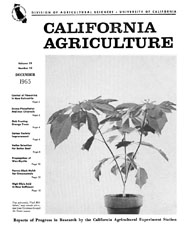


University of California
California Agriculture
|
|||
|
|||

New poinsettia, 'Paul Mikkelsen,' may remain attractive from Christmas through the Easter season.
December 1965
Volume 19, Number 12 |
|||
|
University of California, 1301 S. 46th St., Bldg. 478 Richmond, CA
|